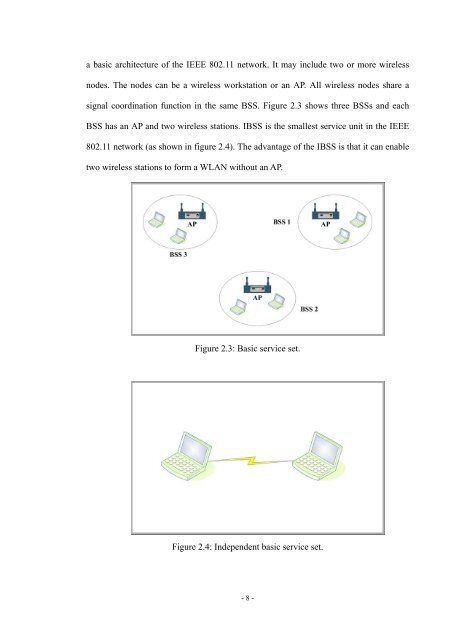- Page 1 and 2: An Investi
- Page 3 and 4: 2.3.5 Signal <stro
- Page 5 and 6: Attestation of Aut
- Page 7 and 8: Abstract Wireless local area networ
- Page 9 and 10: List of Abbreviati
- Page 11 and 12: List of Figures Fi
- Page 13 and 14: List of Tables Tab
- Page 15 and 16: Chapter 1 Introduction There has be
- Page 17 and 18: WLAN performance evaluation and ana
- Page 19 and 20: Chapter 2 Background and Related Wo
- Page 21: The IEEE 802.11 networks have two o
- Page 25 and 26: 2.2.1 Physical Layer Figure 2.8 sho
- Page 27 and 28: throughput significantly at higher
- Page 29 and 30: DCF is designed to provide “best-
- Page 31 and 32: Figure 2.11: Backof</strong
- Page 33 and 34: modulation in [37]. According to si
- Page 35 and 36: Figure 2.12: Net throughput <strong
- Page 37 and 38: As highlighted in [46, 47], distanc
- Page 39 and 40: 2.3.2 Base Station Placement <stron
- Page 41 and 42: gained an insight that this would m
- Page 43 and 44: proposed to improve WLAN performanc
- Page 45 and 46: specifications of
- Page 47 and 48: dynamic and complicated. As argued
- Page 49 and 50: In addition, we surveyed and review
- Page 51 and 52: 4.1 Performance Metrics A stopwatch
- Page 53 and 54: Model: DWL-G132 Specification: Sta
- Page 55 and 56: Figure 4.1: WY building layout. - 4
- Page 57 and 58: Figure 4.2 shows wireless configura
- Page 59 and 60: 4.4.2 Wireless Adapter Configuratio
- Page 61 and 62: 4.4.3 AP Operation Mode Two APs (D-
- Page 63 and 64: meeting room with different distanc
- Page 65 and 66: Scenario 4 In figure 4.12, two APs
- Page 67 and 68: “(H-3.5m)F-H” is the</s
- Page 69 and 70: Figure 4.16: Phase 2 measurement: A
- Page 71 and 72: performed the prop
- Page 73 and 74:
The receiver sensitivity is an impo
- Page 75 and 76:
In table 5.1, the
- Page 77 and 78:
Ethernet connectio
- Page 79 and 80:
sufficient signal coverage and thro
- Page 81 and 82:
throughput decreases along with low
- Page 83 and 84:
In table 5.1, when RSS is larger th
- Page 85 and 86:
(for example, measurement point “
- Page 87 and 88:
AP at Position “R” Figure 5.13
- Page 89 and 90:
The measurement results indicated t
- Page 91 and 92:
5.2.2 Throughput An</strong
- Page 93 and 94:
impact on RSS and throughput. Resul
- Page 95 and 96:
The throughput of
- Page 97 and 98:
The RSS of “WDS
- Page 99 and 100:
The average throughput of</
- Page 101 and 102:
The average data size of</s
- Page 103 and 104:
5.6.1 SOHO Environment Due to <stro
- Page 105 and 106:
The following notes are needed to b
- Page 107 and 108:
when APs were placed at positions
- Page 109 and 110:
Real and accurate results for AP pl
- Page 111 and 112:
Chapter 7 Summary and Conclusions W
- Page 113 and 114:
planning. Propagation measurement (
- Page 115 and 116:
deployment. Many WLANs are deployed
- Page 117 and 118:
placement in indoor wireless system
- Page 119 and 120:
Communications, vol. 2, no. 5, pp.
- Page 121 and 122:
[56] J. K. L. Wong, M. J. Neve, and
- Page 123 and 124:
eceived signal strength of<
- Page 125 and 126:
Appendix A Preliminary Experimental
- Page 127 and 128:
2. AP Mode Measurement in t
- Page 129 and 130:
7. The Ad-Hoc Mode Measurement on <
- Page 131 and 132:
Appendix B Phase 1 Experimental Res
- Page 133 and 134:
(P-1.5m)O-P 32.78 -86 193.6 0.453 N
- Page 135 and 136:
3. Access Point at Position “E-3M
- Page 137 and 138:
(C-5m)C-D 21.63 -83 46.8 1.875 NLOS
- Page 139 and 140:
J 9.00 -44 8.2 10.703 LOS (J-1.5m)J
- Page 141 and 142:
7. Access Point at Position “H”
- Page 143 and 144:
Figure B.2: Throughput map for AP a
- Page 145 and 146:
60 40 20 0 -20 -40 -60 -80 -100 Acc
- Page 147 and 148:
(N-3m)N-O 15.00 -72 15.6 5.626 NLOS
- Page 149 and 150:
(C-3m)C-D 14.32 -74 13.6 6.453 NLOS
- Page 151 and 152:
Figure B.8: Throughput map for AP a
- Page 153 and 154:
60 40 20 0 -20 -40 -60 -80 -100 Acc
- Page 155 and 156:
AP at A RX Position Left-Hand Area
- Page 157 and 158:
AP at L RX Position Left-Hand Area
- Page 159 and 160:
Appendix D Phase 3 Experimental Res
- Page 161 and 162:
TX at 2M from E-3M Data File: 153.6
- Page 163 and 164:
IEEE 802.11 b/g Access Point DWL-21
- Page 165 and 166:
Standards • IEEE 802.11g • IEEE
- Page 167 and 168:
1 Maximum wireless signal rate deri
- Page 169 and 170:
Wireless 108G Standards • 802.11b
- Page 171 and 172:
Wireless 108G Add 802.11g Wireless
- Page 173:
2.4GHz Omni-Directional 7dBi Indoor
















